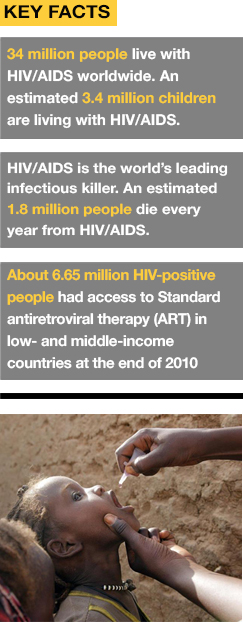
 |
|
 |
 |
 |
 |
 |
 |
 |
| What We Focus On | |||||
| HIV/AIDS & Public Health |  |
|||
Controlling a range of diseases from HIV/AIDS, malaria, polio, neglected tropical diseases and tuberculosis is a critical component to meet the Millennium Development Goals (MDGs) which aim to halve poverty by 2015. Many poor people in impoverished communities are more susceptible to infections because they do not have access to sufficient health care services. Insufficient public health system, child mortality rates and HIV/AIDS epidemics are deeply interrelated. HIV/AIDS has become a devastating pandemic affecting 30 million people, most of them living in developing countries. In 2010, there were an estimated 22.9 million HIV-infected patients in Sub-Saharan Africa. In 2010, more than 5 million Africans received antiretroviral treatment for HIV/AIDS, and were liberated from their death sentences. But the access to preventive interventions remains low in most impoverished countries. Although mother-to-child-transmission of HIV/AIDS is almost avoidable, only 48% of pregnant women with HIV received the most effective regimens (as recommended by WHO) to prevent the virus. In 2011, nearly 1.4 million died from Tuberculosis (TB) and there were about 10 million orphan children as a result of TB deaths among parents. TB is second only to HIV/AIDS as the greatest killer worldwide due to a single infectious agent. Over 95% of TB deaths occur in low- and middle-income countries. Although the TB death rate dropped 41% between 1990 and 2011, the world is still on track to reverse the spread of TB by 2015. Since the Global Polio Eradication Initiative (GPEI) was launched in 1988, the incidence of polio has decreased by more than 99 percent through immunization efforts. In 2012, the World Health Assembly declared polio a global health emergency. However, insufficiency of financing required some emergency eradication activities to be scaled back in 24 at risk countries including Pakistan, Afghanistan and Nigeria. Moreover, neglected tropical diseases (NTD) are a group of preventable and treatable infections including trachoma, dengue, guinea-worm disease, trachoma, which cause chronic illness and malnutrition. NTDs can be easily treated, but the disabling effects of untreated NTDs have an enormous impact on the work force and consequently the productivity of communities. NTDs are often considered low priority in national health programs and are neglected in health agendas and budgeting because of the high-visibility and high-mortality diseases like HIV/AIDS, malaria and tuberculosis. |
 |
|||
|
GP3 Korea 2013. Creative Commons Attribution-Non Commercial-ShareAlike 2.0 License The Global Poverty Public Awareness Project in Korea. Designed by Jeong-ae Lee, Ranhee Kim, Suk-hwan Lim, Jaewoo Choi, Ji-won Oh & Seung-won Baek |